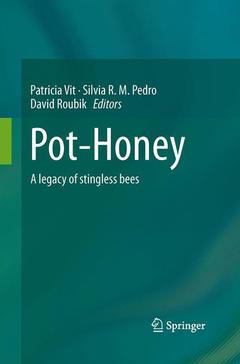Foreword.- Introduction.- I. Origin, biodiversity and behavior of the stingless bees (Meliponini).- 1. The Meliponini.- 2. Historical biogeography of the Meliponini (Hymenoptera, Apidae, Apinae) of the Neotropical region.- 3. Australian stingless bees.- 4. Stingless bees from Venezuela.- 5. Stingless bees (Hymenoptera: Apoidea: Meliponini) of French Guiana.- 6. Stingless bees of Guatemala.- 7. Stingless bees of Costa Rica.- 8. Stingless bees in Argentina.- 9. Mexican stingless bees (Hymenoptera: Apidae): Diversity, biogeography, and indigenous knowledge.- 10. The role of useful microorganisms to stingless bees and to stingless bee keeping.- 11. Microorganisms associated with stingless bees.- 12. Stingless bee food location communication: from the flowers to the honey pots.- 13. On competition and the diversity of food-collection strategies in stingless bees.- II. Stingless bees in culture, traditions and environment.- 14. Stingless bees: An historical perspective. 15. Medicinal uses of Melipona beecheii pot-honey, by the ancient Maya.- 16. Hans Staden’s first report from 1557 on collection of stingless bee honey by an indigenous tribe in Brazil.- 17. The Melipona bee in the scientific world: Western cultural views.- 18. Taxonomy as a tool for conservation of African stingless bees and their honey.- 19. Effects of human disturbance and habitat fragmentation on stingless bees.- III. What plants are used by the stingless bees?.- 20. Palynology serving the stingless bees.- 21. How to be a bee botanist using pollen spectra.- 22. Plants used by stingless bees for nesting and as floral resources.- 23. Botanical origin of pot-honey Tetragonisca angustula Latreille in Colombia.- IV. Sensory attributes and composition of pot-honey.- 24. Sensory evaluation of pot-honey.- 25. Melipona favosa pot-honey fromVenezuela.- 26. Tetragonisca angustula pot-honey compared to Apis mellifera honey from Brazil.- 27. Honey of Colombian native bees.- 28. The pot-honey of Guatemalan stingless bees.- 29. Pot-honey of six species of Meliponini from Amboró National Park in Bolivia.- 30. Electronic nose and physicochemical analysis to differentiate Colombian pot-honey.- 31. Nuclear Magnetic Resonance as a method for molecular profiling and prediction of geographical and entomological origin of pot-honey.- 32. Non-aromatic organic acids of honeys.- V. Biological properties.- 33. Flavonoids in stingless-bee and honey-bee honeys.- 34. Antioxidant activity of pot-honey.- 35. Use of honey in cancer prevention and therapy.- 36. Bioactivity of honey and propolis from Tetragonula laeviceps in Thailand.- 37. Costa Rican pot- honey: Its medicinal use and antibacterial effect.- 38. Immunological properties of bee products.- 39. Chemical properties of propolis collected by stingless bees.- VI. Marketing and standards of pot-honey.- 40. Production and marketing of pot-honey.- Appendix.- 1. Taxonomic index of bee species.- 2. List of bee taxa.- 3. Common names of stingless bees.- 4. Taxonomic index of plant families.- 5. List of plant taxa used by bees.- 6. Common names of plants used for nesting by stingless bees.- 7. Common names of medicinal plants used with honey by Mayas.- 8. Microorganisms associated to stingless bees or used to test antimicrobial activity.- 9. Summary of meliponine and Apis mellifera honey composition.- 10. Information of collected stingless bees.- Subject list.- Authors list.




